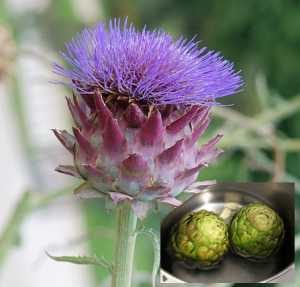How to Grow Globe Artichokes – A Guide to Growing Globe Artichokes
 Globe and Jerusalem artichokes share a name only. Jerusalem artichokes are grown for their potato-style roots; globe artichokes for their flower heads. The plants require some effort to grow, prepare and eat.
Globe and Jerusalem artichokes share a name only. Jerusalem artichokes are grown for their potato-style roots; globe artichokes for their flower heads. The plants require some effort to grow, prepare and eat.
Globe artichokes are a member of the thistle family and grow into extremely large plants (1.5 m/5 feet) in diameter. However, they are an attractive plant and can provide an architectural centre point in the garden, although a demanding and sparse crop for the space taken up.
Sowing and Growing Globe Artichokes
- Start off in early or mid-spring.
- Harvest June–July the following year.
- Difficult to grow from seed and usually cultivated from rooted offsets (suckers), planted in early–mid-spring. Remember they are going to be a permanent feature of your plot for a few years.
- In the first year keep the plants weed-free and watered if dry. They are hungry plants – mulch with well-rotted manure or compost and liquid feed every two weeks or so.
- As small heads start to develop during the first year, cut them off and discard to reserve strength for the following year.
- In late autumn, cut off the foliage and mulch the crowns to protect them over winter. Pile leaves or straw over the crown, keep in place with wire netting and cover with plastic sheeting to keep dry.
- In spring, as the plants begin to grow again, remove the mulch. Feed the plants as they start to produce heads in June–July.
Harvesting Globe Artichokes
- Remove the main stem head first (this is called the king head), and then remove the secondary heads as they develop. Do not allow a plant to develop more than six heads in this second year. From the third year onwards, you can allow up to twelve heads per plant. Once cut, reduce the stem by half.
- The plants will be productive for four–six years and you can harvest rooted suckers and so grow more plants. Select from your best plants and you will improve your strain over the years.
Pests and Problems with Globe Artichokes
- Slugs and aphids are the only likely problems. The slugs will damage the growing tips and can defoliate the plants, if allowed. Sometimes the artichoke heads will become infested with aphids.
Varieties of Globe Artichokes
- There are several varieties of globe artichoke available.
Preparing & Eating Globe Artichokes
Globe artichokes can be used in various recipes and frozen. However, they’re considered a gourmet dish, prepared in this way:
- Cut the stalk level with the base of the head.
- Remove any damaged scales and trim the points off the remaining scales with sharp scissors.
- Remove the hairy central choke (which is inedible).
- Boil for around 40 minutes until tender.
- To eat, pull off each scale and suck the fleshy base of each scale with a dressing (leaving the point). The central heart is eaten afterwards with a spoon.



